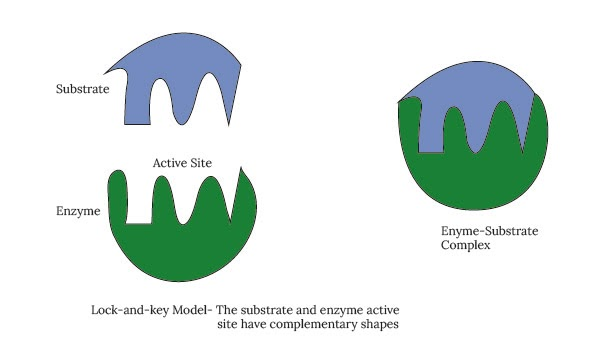
What is an enzyme-substrate complex?
Answer
505.8k+ views
Hint: The activation energy is reduced by the enzymes as they speed up the reactions by bringing together the reactants. It is unique in nature and shows a varying degree of specificities, while they are highly specific for a particular substrate.
Complete answer
Enzymes are specific in nature and they have a particular shape, consequently, only a specific substrate will fit its active site. There are two theories of enzyme activity: Lock and Key and Induced Fit. The lock and key theory describes that only a specific substrate will fit a specific active site, much the same as a key fit a lock. Induced Fit, in like manner, expresses that enzymes wrap around substrates, attracted to one another by opposite charges, forming an enzyme-substrate complex.
Enzymes are incredibly effective and have extraordinary catalytic power, changing around 100 to 10,000 substrate molecules into product every second and continuing from 103 to 108 to multiple times quicker than the uncatalyzed reaction. Enzymes don’t affect the equilibrium constant notwithstanding the increase in the conversion rate of the substrate into the product.
Additional information
Enzyme Catalysis - These are catalysts in the living system. The rate of any biological event can be altered by substances as enzymes. These are basically proteins, and catalyst activity is structure explicit.
Enzyme catalysis is the expansion in the rate of a chemical response by the active site of a protein.
Enzymes are the macromolecular natural catalysts. These are profoundly particular catalysts significantly quickening both the rate and explicitness of metabolic reaction. All enzymes exist in colloidal form thus they are insoluble. Urease is an enzyme that catalyzes the hydrolysis of urea, which can form ammonia and carbon dioxide.
Note:
The enzyme was first discovered in 1833 by the French chemist Anselme Payen. The first enzyme was Diastase which was discovered. The specific enzyme action with one substrate was first explained in 1894 through the lock and key theory by Emil Fischer where the enzyme represents the lock while the substrate represents the key.

Complete answer
Enzymes are specific in nature and they have a particular shape, consequently, only a specific substrate will fit its active site. There are two theories of enzyme activity: Lock and Key and Induced Fit. The lock and key theory describes that only a specific substrate will fit a specific active site, much the same as a key fit a lock. Induced Fit, in like manner, expresses that enzymes wrap around substrates, attracted to one another by opposite charges, forming an enzyme-substrate complex.
Enzymes are incredibly effective and have extraordinary catalytic power, changing around 100 to 10,000 substrate molecules into product every second and continuing from 103 to 108 to multiple times quicker than the uncatalyzed reaction. Enzymes don’t affect the equilibrium constant notwithstanding the increase in the conversion rate of the substrate into the product.
Additional information
Enzyme Catalysis - These are catalysts in the living system. The rate of any biological event can be altered by substances as enzymes. These are basically proteins, and catalyst activity is structure explicit.
Enzyme catalysis is the expansion in the rate of a chemical response by the active site of a protein.
Enzymes are the macromolecular natural catalysts. These are profoundly particular catalysts significantly quickening both the rate and explicitness of metabolic reaction. All enzymes exist in colloidal form thus they are insoluble. Urease is an enzyme that catalyzes the hydrolysis of urea, which can form ammonia and carbon dioxide.
Note:
The enzyme was first discovered in 1833 by the French chemist Anselme Payen. The first enzyme was Diastase which was discovered. The specific enzyme action with one substrate was first explained in 1894 through the lock and key theory by Emil Fischer where the enzyme represents the lock while the substrate represents the key.

Recently Updated Pages
Master Class 11 Economics: Engaging Questions & Answers for Success

Master Class 11 English: Engaging Questions & Answers for Success

Master Class 11 Social Science: Engaging Questions & Answers for Success

Master Class 11 Biology: Engaging Questions & Answers for Success

Class 11 Question and Answer - Your Ultimate Solutions Guide

Master Class 11 Business Studies: Engaging Questions & Answers for Success

Trending doubts
10 examples of friction in our daily life

One Metric ton is equal to kg A 10000 B 1000 C 100 class 11 physics CBSE

Difference Between Prokaryotic Cells and Eukaryotic Cells

1 Quintal is equal to a 110 kg b 10 kg c 100kg d 1000 class 11 physics CBSE

State the laws of reflection of light

Explain zero factorial class 11 maths CBSE




